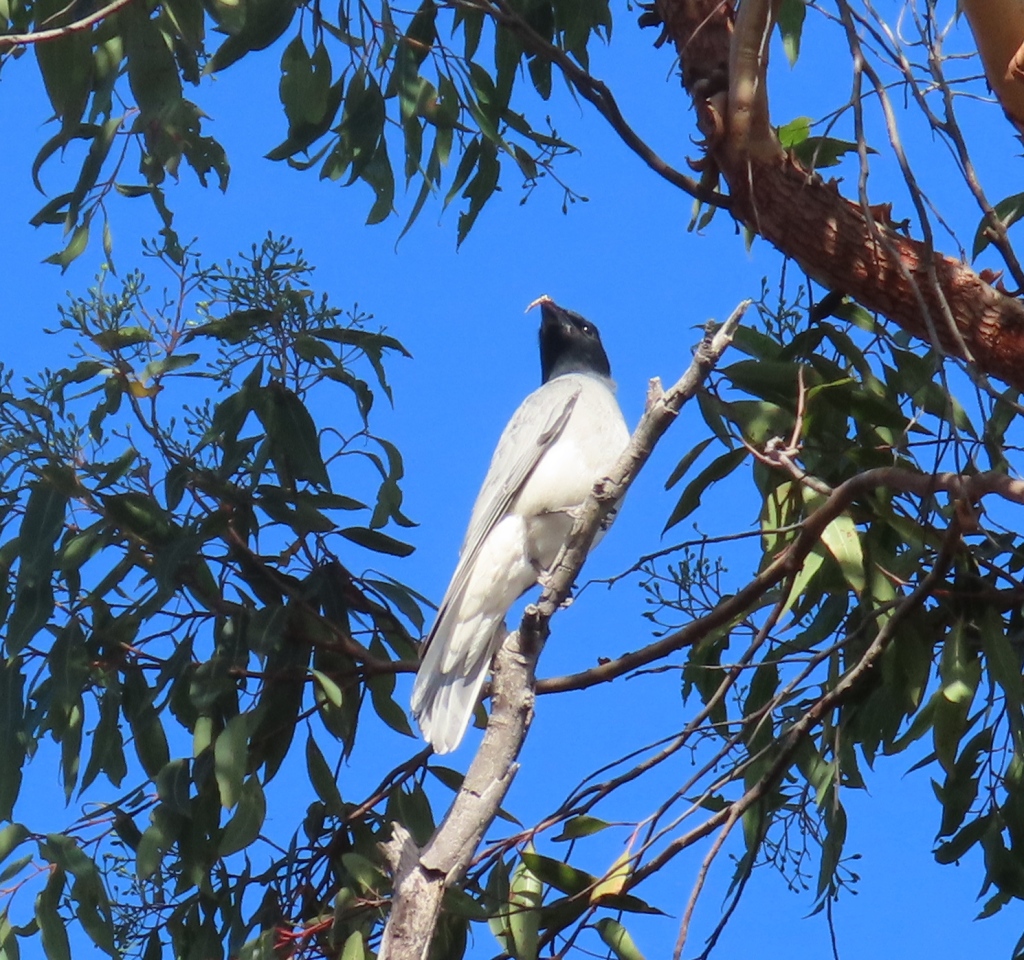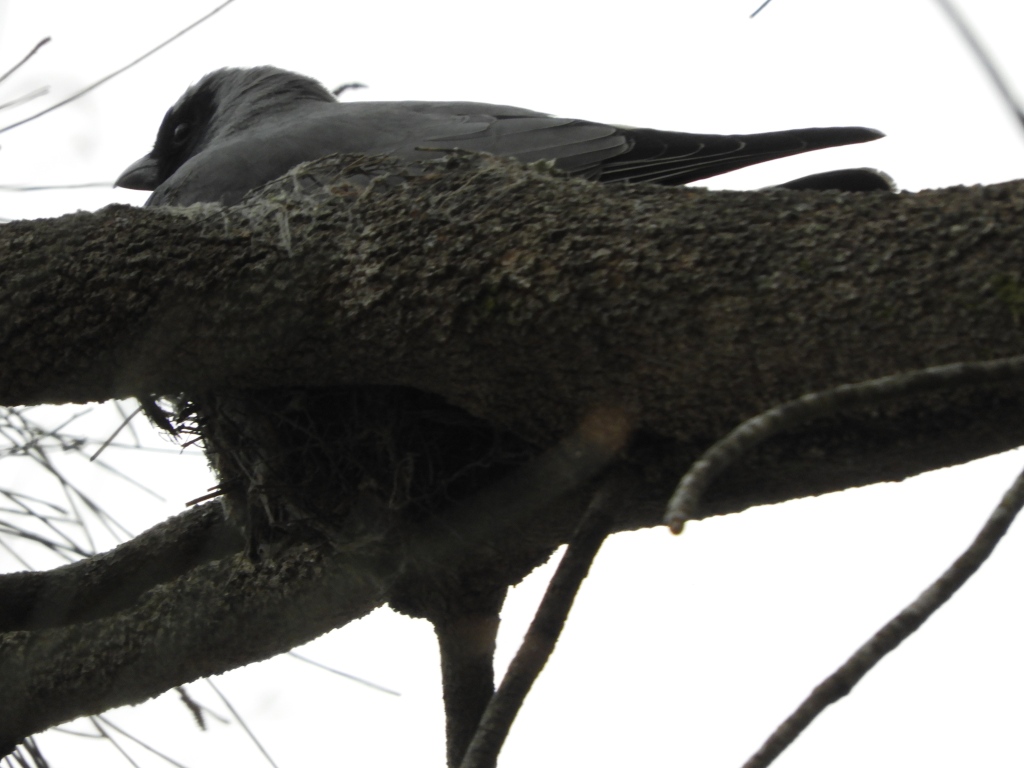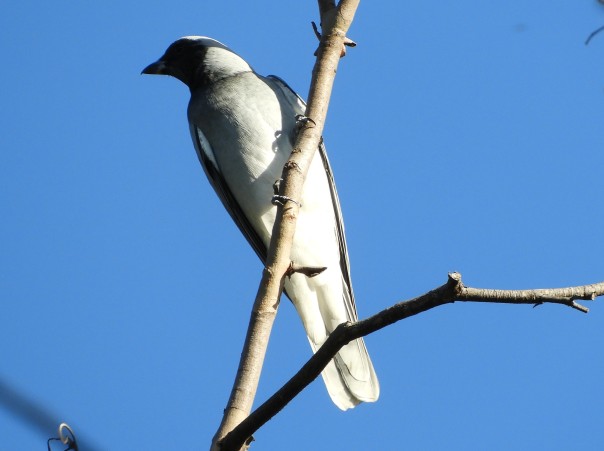Category Archives: Cuckoo-shrike
Shufflewings earning their name
Black-faced Cuckoo-shrikes are a type of bird with the nickname “Shufflewings” because they like to move their wings up and down while perching on a branch. They do it when they land and, I’ve just seen, also when they want to attract each other’s attention. The wing shuffle is almost like a little dance. This video shows two of the birds shuffling at each other:
Don’t let the official name, Black-faced Cuckoo-shrikes, deceive you. These birds aren’t shrikes or cuckoos. Evidently the reason they were given this name is that their beaks have the same hooked end as a shrike’s and their feathers have similar patterns to some cuckoos.
Check out the other Black-faced Cuckoo-shrikes that I’ve spotted over time.
Common name: Black-faced Cuckoo-shrike, also called a Shufflewing
Scientific name: Coracina novaehollandiae
Approximate length: 35 cm
Date spotted: 27 November 2024 (spring)
Location: Manly Dam Park, New South Wales, Australia: 33°46’32.9″S 151°14’47.7″E
Young Shufflewing being fed
Black-faced Cuckoo-shrikes are often called Shufflewings, because they flip their wings up and down a little each time they land. I hear the birds calling often while walking in the bush, and see them sometimes too. Usually, though, they’re high in the treetops and difficult to spot. It’s been a long-time ambition of mine to catch a video of one doing the wing-shuffle.
Today was my lucky day. Not only did I film the wing-shuffle of an adult Black-faced Cuckoo-shrike, but I also saw a juvenile being fed by adults. The birds were quite low down in a Casuarina tree, probably because that’s where the youngster landed after emerging from its nest.
In the first video, an adult bird lands next to the youngster and feeds it a parcel of food before flying off to a higher branch. The adult sits up high for a while, holding another tasty morsel in its beak. Adult and child trill softly to each other. The adult then drops down and feeds the little one again. When it lands on another branch, it does one of its characteristic wing-shuffles.
The second video starts with an adult bird carrying some food in its beak. The bird visits the youngster, passes over the food and hangs around for a short time, then flies off. The youngster takes some time to swallow the food, while gazing around and calling for the next morsel.
Here’s a still picture of the young bird:

The youngster again, from a different angle:

Here’s the adult, posed neatly against a blue sky:

Despite their name, Black-faced Cuckoo-shrikes aren’t shrikes, nor even cuckoos. Evidently they acquired the name because their beaks have the same hooked end as a shrike’s and their feathers have similar patterns to some cuckoos.
These are beautiful, graceful birds to see and hear. I’ve posted descriptions of other Black-faced Cuckoo-shrikes that I’ve spotted over time.
Common name: Black-faced Cuckoo-shrike, also called a Shufflewing
Scientific name: Coracina novaehollandiae
Approximate length: 35 cm
Date spotted: 22 December 2023 (summer)
Location: Manly Dam Park, New South Wales, Australia: 33°46’53.2″S 151°15’08.0″E
(Sad) Nest of Black-faced Cuckoo-shrike disappeared
Black-faced Cuckoo-shrikes are smart-looking birds, with a neat covering of smooth grey feathers and a dark face. I was delighted when I noticed a nesting couple on one of my regular walks, and have been watching their progress with pleasure.
Here’s a photo of one of the parent birds, taken on 17 October:

Common name: Black-faced Cuckoo-shrike, also called a shufflewing
Scientific name: Coracina novaehollandiae
Approximate length: 35 cm
Location: Manly Dam Park, New South Wales, Australia: 33°46’35.5″S 151°14’51.2″E
Here’s a parent sitting on the nest (photo taken on 11 November):

And a side view, taken on 17 October:

This is the nest, taken while both parents were briefly out of view (4 November):

This video shows the first time, and alas the last time, that I caught a glimpse of the chicks. The images are in silhouette, because it was early in the morning with the bright sky behind the birds. Even so, you can see the beak of a young chick. It’s also interesting to see how the parent cleans the nest after feeding its young:
I shot the above video on Wednesday 11 November, just a few days ago. On Thursday and Friday, I walked past the tree and saw the birds sitting on the nest as usual. Today, Sunday, I went back to the area and the nest has completely disappeared.

It’s likely that the birds had a visit from a monitor lizard, or a possum, or even a human. (The nearby picnic area had been significantly vandalised too.)
It’s so sad to see all that effort by the parent birds go to waste, and to think what may have been the fate of the chicks. I do hope the parents survived to have another family next year.
Black-faced Cuckoo-shrike in frame at last
I have just a very short, shaky video and two stills, but I’m so pleased I managed to get a Black-faced Cuckoo-shrike in the frame at last. I’ve seen and heard these birds a few times. They have a soft, chirring call and they swoop and glide high in the tree tops. When they come to rest, they’re either well shielded by foliage, or they fly off after just a short stop.
They have quite large eyes, and soft white and grey plumage:
This shot shows off the black face that gives the bird its name:
Common name: Black-faced Cuckoo-shrike, also called a shufflewing
Scientific name: Coracina novaehollandiae
Approximate length: 35 cm
Date spotted: 5 May 2018 (Autumn)
Location: Manly Dam National Park, New South Wales, Australia: 33°46’50.1″S 151°15’04.5″E



